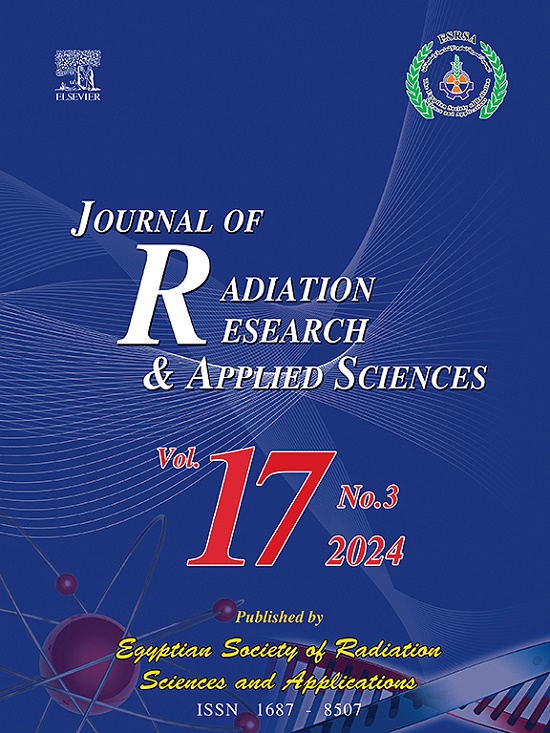Advancements and challenges in CT image segmentation for COVID-19 diagnosis through augmented and virtual Reality: A systematic review and future perspectives
IF 1.7
4区 综合性期刊
Q2 MULTIDISCIPLINARY SCIENCES
Journal of Radiation Research and Applied Sciences
Pub Date : 2025-03-22
DOI:10.1016/j.jrras.2025.101374
引用次数: 0
Abstract
This article presents a systematic exploration of the synergy between artificial intelligence (AI) and immersive technologies augmented reality (AR) and virtual reality (VR) in diagnosing Coronavirus disease 2019 (COVID- 19) using computerised tomography (CT) medical imaging. Prior reviews have separately tackled COVID-19 CT diagnosis, focusing extensively on image segmentation and classification tasks, often encompassing both CT and X-ray images. However, an integrated consideration of AI, immersive technologies, and CT image segmentation for COVID-19 diagnosis has been notably absent in existing literature. To bridge this gap, our analysis concentrates on methods merging CT image segmentation with AR and VR for COVID-19 diagnostics, leveraging prominent search engines and databases: Google, Google Scholar, IEEE Xplore, Web of Science, PubMed, ScienceDirect, and Scopus. Our in-depth examination furnished comprehensive insights from each selected research, revealing the promising potential of AI and immersive technologies in expediting COVID-19 diagnosis through process automation. The development of precise and rapid diagnostic models holds considerable promise for real-time clinical application, even though further research is imperative. This review categorises the literature on CT image segmentation employing AR and VR technologies, laying a solid foundation for future research endeavours in this promising intersection. The authors conducted an extensive analysis, focusing on methodologies that combine deep learning based CT image segmentation based on Deep Learning with AR and VR for COVID-19 diagnostics. The study outcomes highlight the transformative potential of Augmented Reality (AR) and Virtual Reality (VR) in enhancing healthcare delivery during the COVID-19 pandemic, particularly in aiding diagnosis and treatment planning. Furthermore, the widespread adoption of Artificial Intelligence (AI) and deep learning models has been proven to be instrumental in detecting COVID-19 infections from chest CT images, offering automated diagnostic solutions that streamline workflows, reduce patient contact, and improve efficiency for medical professionals. VR, AR and AI integration presents a promising avenue for advancing diagnostic precision and patient treatment strategies. However, the use of VR and AR in healthcare raises significant privacy and security concerns due to the handling of sensitive patient data, underscoring the need for robust regulatory frameworks to govern their application. Lightweight deep learning (DL) models facilitate efficient on-device processing, significantly enhancing their utility, scalability, and real-time deployment in resource-constrained environments. Together, these findings demonstrate the significant role of emerging technologies in addressing pandemic challenges, while highlighting the importance of addressing ethical and regulatory considerations.
增强和虚拟现实CT图像分割在COVID-19诊断中的进展与挑战:系统综述和未来展望
本文系统探讨了人工智能(AI)和沉浸式技术增强现实(AR)和虚拟现实(VR)在利用计算机断层扫描(CT)医学成像诊断2019冠状病毒病(COVID- 19)中的协同作用。之前的综述分别讨论了COVID-19 CT诊断,广泛关注图像分割和分类任务,通常包括CT和x射线图像。然而,现有文献明显缺乏综合考虑人工智能、沉浸式技术和CT图像分割的COVID-19诊断。为了弥补这一差距,我们的分析集中在将CT图像分割与AR和VR合并用于COVID-19诊断的方法上,利用著名的搜索引擎和数据库:谷歌、谷歌Scholar、IEEE Xplore、Web of Science、PubMed、ScienceDirect和Scopus。我们的深入研究为每项选定的研究提供了全面的见解,揭示了人工智能和沉浸式技术在通过流程自动化加快COVID-19诊断方面的巨大潜力。精确和快速诊断模型的发展为实时临床应用提供了可观的希望,尽管进一步的研究是必要的。本文对采用AR和VR技术的CT图像分割的文献进行了分类,为未来在这一有前途的交叉领域的研究奠定了坚实的基础。作者对基于深度学习的基于深度学习的CT图像分割与AR和VR相结合的新冠肺炎诊断方法进行了广泛的分析。研究结果强调了增强现实(AR)和虚拟现实(VR)在COVID-19大流行期间加强医疗保健服务方面的变革潜力,特别是在帮助诊断和治疗计划方面。此外,人工智能(AI)和深度学习模型的广泛采用已被证明有助于从胸部CT图像中检测COVID-19感染,提供自动化诊断解决方案,简化工作流程,减少患者接触,提高医疗专业人员的效率。VR、AR和AI的整合为提高诊断精度和患者治疗策略提供了一条有前途的途径。然而,由于处理敏感的患者数据,在医疗保健中使用VR和AR引起了重大的隐私和安全问题,强调需要强有力的监管框架来管理其应用。轻量级深度学习(DL)模型促进了高效的设备上处理,显著提高了它们在资源受限环境中的实用性、可扩展性和实时部署。总之,这些发现表明了新兴技术在应对大流行病挑战方面的重要作用,同时强调了解决伦理和监管问题的重要性。
本文章由计算机程序翻译,如有差异,请以英文原文为准。
求助全文
约1分钟内获得全文
求助全文
来源期刊

Journal of Radiation Research and Applied Sciences
MULTIDISCIPLINARY SCIENCES-
自引率
5.90%
发文量
130
审稿时长
16 weeks
期刊介绍:
Journal of Radiation Research and Applied Sciences provides a high quality medium for the publication of substantial, original and scientific and technological papers on the development and applications of nuclear, radiation and isotopes in biology, medicine, drugs, biochemistry, microbiology, agriculture, entomology, food technology, chemistry, physics, solid states, engineering, environmental and applied sciences.
 求助内容:
求助内容: 应助结果提醒方式:
应助结果提醒方式:


